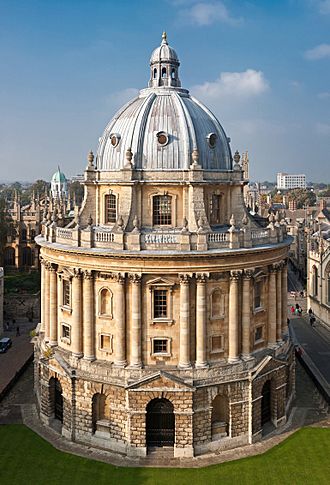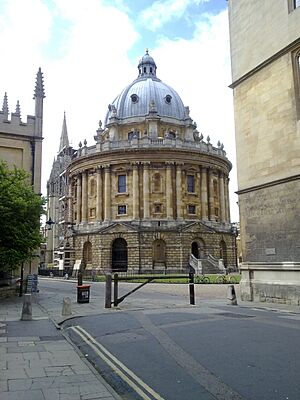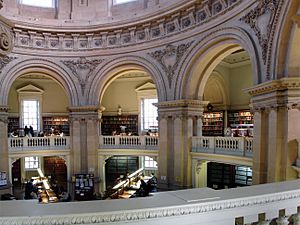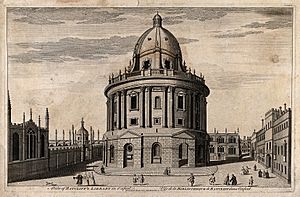Radcliffe Camera facts for kids
Quick facts for kids Radcliffe Camera |
|
|---|---|

Radcliffe Camera, viewed from the University Church
|
|
| Former names | Physics Library |
| Alternative names | Rad Cam or Radders or The Camera (colloquial) |
| General information | |
| Type | Academic library |
| Architectural style | English Palladian style |
| Location | Radcliffe Square, Oxford |
| Coordinates | 51°45′12″N 1°15′14″W / 51.7534°N 1.2539°W |
| Construction started | 17 May 1737 |
| Completed | 1748 |
| Inaugurated | 13 April 1749 |
| Owner | University of Oxford |
| Technical details | |
| Floor count | 2 plus a mezzanine |
| Design and construction | |
| Architect | James Gibbs |
The Radcliffe Camera is a famous building at Oxford University in England. People often call it the "Rad Cam" or "The Camera". The word "camera" comes from Latin and means 'room'.
This beautiful building was designed by James Gibbs in a style called neo-classical. It was built between 1737 and 1749. Its original purpose was to hold the Radcliffe Science Library. The Radcliffe Camera is located in the heart of Oxford. It stands near the University Church and between Brasenose College and All Souls College. Because of its unique round shape and central spot, it's a very recognizable symbol of Oxford University.
The money for building and keeping up the library came from John Radcliffe. He was a doctor who left £40,000 when he died in 1714. Building started in 1737, after a long process of buying the land. The outside of the building was finished by 1747. The inside was ready by 1748, but the library didn't open until April 13, 1749.
When it first opened, Francis Wise became its first librarian. For many years, it held all kinds of books. But after 1810, under George Williams, it focused only on science books. Later, in the 1850s, Henry Wentworth Acland, who was the librarian then, suggested a big change. He proposed that the Radcliffe Library building should become part of the university. The science books would move to a new building, the Radcliffe Science Library. This plan was accepted. That's when the building became known as the Radcliffe Camera. It started being used as a reading room for the main Bodleian Library. Some visitors think it holds rare books, but those are mostly in the nearby Weston Library and Duke Humfrey's Library.
Contents
Building History
How it Started
John Radcliffe (around 1650–1714) went to University College when he was 13. He became a fellow at Lincoln College at 18. He was a very successful doctor. His patients included kings and queens, like William III and Queen Anne. He became very rich and had no children. He is buried in St. Mary's Church in Oxford.
Radcliffe wanted to build a library in Oxford. He had this idea at least two years before he died in 1714. At first, people thought the new building would be an addition to the Bodleian Library. But by 1714, Radcliffe decided on a different location. He chose a spot south of the Bodleian.
Planning the Library
Radcliffe died on November 1, 1714. His will said that £40,000 should be used to build a library in Oxford. This money would also buy the houses needed for the building site. He also set aside money each year for the librarian and for buying books. The librarian would be chosen by many important people, including the Archbishop of Canterbury and the Lord Chancellor.
The building site was complicated. It had houses, gardens, and parts of other colleges like Brasenose College. The people in charge of Radcliffe's money, called Trustees, had to buy all this land. This process took over 20 years! An Act of Parliament was even passed in 1720 to help the university sell land for the library.
The Trustees considered several famous architects. These included Christopher Wren and James Gibbs. By 1734, only Nicholas Hawksmoor and James Gibbs were still options. Hawksmoor died in 1736, so Gibbs was chosen as the architect. Gibbs was paid £100 a year to oversee the building. He also had to draw all the plans and visit the site four times a year.
Building the Camera
The first stone was laid on May 17, 1737. The Trustees decided on a special message to be put on a copper plate for the stone. The message was in Latin and honored the University and the people involved.
Many skilled workers were hired for the project. These included masons, carpenters, plumbers, and carvers. William Townsend and William Smith were the main masons. John Philipps was the carpenter. Joseph Artari was the plasterer. John Michael Rysbrack was the sculptor who made a marble statue of John Radcliffe.
Building went smoothly until February 1741. There was a problem with the dome. It was partly built from stone, but then all work stopped. The Trustees decided to change the plan. Part of the stone dome was removed. The dome was then finished with timber and covered in lead. This problem took over a year to fix. The dome was finally completed by March 1743. Sadly, two workers died in an accident when the scaffolding was being removed.

Once the main structure was done, work began on the inside. John Phillips worked on the floors, windows, and bookshelves. Joseph Artari did the plasterwork. A large marble statue of John Radcliffe was made by John Michael Rysbrack. It was six feet tall. Iron gates for the outside arches were made by Robert Bakewell.
The outside of the building was finished by 1747. The whole building was completed in 1748. The first librarian, Francis Wise, was appointed in 1748. The library finally opened on April 13, 1749. The area around the library was also improved. Stone posts with gas lamps were put up in 1751 to light the area at night.
Life as a Library
Early Years
The library's collection of books grew slowly at first. The first book placed there was a history book. It also received a large donation of pamphlets. The library quickly became known as 'the Physic Library' because it was connected to medicine. Even though it was called that, it bought many different kinds of books for the first 60 years. But from 1811, it focused only on science books. In the early 1800s, it also held coins, statues, and other collections. These have since been moved to other museums.
The library had a special room for important documents about Radcliffe's will and the land. But some documents got damaged over time. So, the remaining ones were moved to the main library to keep them safe. The first librarian, Francis Wise, had some problems. His health was poor, and he didn't get along well with the University. He thought the library was independent, but the University believed it was part of them.
Changes and Growth
After Wise, Benjamin Kennicott became librarian. He bought more books on Arabic, Hebrew, and Persian studies. However, the building itself started to fall apart. People at the time said the collection was not very good compared to other libraries. The next librarian, Thomas Hornsby, didn't do much to improve things either. No new books were bought during his time.
A new era began when George Williams became librarian. He was a doctor and a professor of botany. He decided to focus the library's collection entirely on science books. A lot of money was spent on new books. The library also received marble busts and a collection of marble samples. In 1827, railings were put around the library grounds. When Williams died in 1834, the Trustees thanked him greatly for his hard work.
John Kidd took over next. Gas heating and lighting were added to the library. A third staff member, an assistant, was hired. Insurance was taken out in case of fire. In 1835, the library's catalog was finally published. The book collection kept growing. A visitors' book was started to tell the difference between students and curious tourists.
Becoming a Reading Room
Henry Wentworth Acland became librarian after Kidd. He made some changes to the building, like creating a reading room and improving the lighting and heating. He felt that the money for new books was not enough. So, he suggested a big change: the Radcliffe Library should become part of the University.
In 1856, Acland explained his plan to the Trustees. He said that the library, with about 14,000 to 15,000 books, was not as useful as people thought. He pointed out that the Bodleian Library had more science books. His plan was for the Radcliffe Library building to become a reading room for the Bodleian. The science books would move to the new Radcliffe Science Library. Both the Trustees and the University agreed to this plan. On October 23, 1861, the keys to the Radcliffe Library building were given to the Bodleian's librarian. It took four more years to finish everything. This is how the Radcliffe Library building became the Radcliffe Camera, a reading room.
Modern Use
Between 1909 and 1912, an underground book storage area was built beneath the north lawn of the library. A tunnel connected it to the Bodleian Library. This link was called the "Radcliffe Link" or "the Link." It was made into new reading rooms in 2011 and is now known as the "Gladstone Link."
Today, the Radcliffe Camera is still used as reading rooms for the Bodleian Library. The upper reading room has a six-foot marble statue of John Radcliffe. It now holds books on English, history, and theology. These are mostly books that students need for their studies. There is space for about 600,000 books in the rooms under Radcliffe Square.
In November 2010, students occupied the Radcliffe Camera for over 24 hours. This was part of a larger protest against changes to university funding and higher tuition costs.
Building Design
The Radcliffe Camera is the first round library building in England. It has three main parts on the outside and two floors inside. The top floor has a gallery. The bottom part of the building has a rough, textured stone finish. It has eight sections that stick out, with arched openings between them.
The middle part has columns that support a continuous stone band. The windows have triangular tops and are above smaller openings. The top part is a dome with a small tower (lantern) on an eight-sided base. It has a railing with decorative vases.
The building was made using local stone from Headington and Burford. The dome and the small tower are covered with lead. Inside, the walls and dome were originally painted. Later, the paint was removed, showing the stone carvings. Only the decorations on the dome are made of plaster.
Originally, the basement was an open area with arches and a stone ceiling. Radcliffe's coat of arms was in the center. Iron grilles were in the arches. Three of these were gates that led to the library's grand staircase. In 1863, when the building became a reading room, the arches were filled with glass. A new entrance was made on the north side, with stone steps leading up to it.
The area around the library was originally paved, cobbled, and graveled. In 1751, stone posts with lamps were placed around the edge. Most of these were removed around 1827 when lawns were added and iron railings were installed.
Images for kids
See also
 In Spanish: Cámara Radcliffe para niños
In Spanish: Cámara Radcliffe para niños





